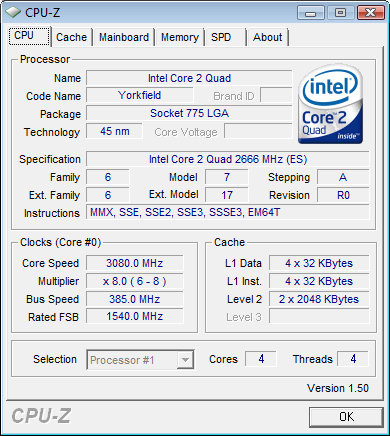The Core 2 Quad Q8400: Intel's $183 Phenom II 940 Competitor
by Anand Lal Shimpi on May 7, 2009 12:00 AM EST- Posted in
- CPUs
Overclocking at Stock Voltages
The Phenom II X4 940 was AMD's first Phenom II to hit the market, the downside being that it wasn't the best example of AMD's 45nm manufacturing process. While the chips could overclock, their headroom without increasing their default core voltage just wasn't that high. The 940 we used for this review could only make it to 3.2GHz with a 2.2GHz NB frequency without increasing core voltage beyond the default 1.35V (as reported by the BIOS, 1.336V as reported by CPU-Z):

Phenom II X4 940 max overclock at stock voltage
The Core 2 Quad Q8400 on the other hand is based on a core that's been shipping for quite a while, at stock voltage using the stock cooler I was able to hit 3.08GHz:

Now remember that Phenom II isn't faster than Intel's Core 2 Quad clock for clock. AMD gets an advantage only because it sells higher clocked Phenom IIs at the same price as lower clocked Core 2 Quads. With only a 4% clock speed advantage, the performance is distinctly in Intel's favor:
| Processor | Adobe Photoshop CS4 | x264 HD - 2nd pass | POV-Ray | Far Cry 2 | Idle Power | Load Power |
| AMD Phenom II X4 940 @ 3.2GHz | 22.3s | 19.0 fps | 2539 | 51.5 fps | 120.2W | 209W |
| Intel Core 2 Quad Q8400 @ 3.08GHz | 19.7s | 20.4 fps | 2597 | 53.5 fps | 131.9W | 181.5W |
Photoshop and Far Cry 2 were both Q8400's strengths at stock clock speeds, so it makes sense that the Q8400 would widen the gap after we overclocked both chips. The x264 and POV-Ray tests were equal and in AMD's favor, respectively, at stock clocks. When overclocked without touching anything but the clock multiplier in the case of the Phenom II or FSB frequency and memory ratios in the case of the Core 2 Quad.
There is merit to looking at this sort of overclocking performance since it's the simplest way to overclock, but if you're willing to give your chip a little more voltage you can get a lot more clock speed...










60 Comments
View All Comments
erple2 - Saturday, May 9, 2009 - link
while there may be fewer defects per wafer, there are also fewer chips per wafer (about 57% fewer). To take the analogy to the extreme, lets say that AMD makes one chip that consumes the entire wafer, and Intel can make 2. If there is, on average, 1 defect per wafer for AMD and 5 defects per wafer for Intel, AMD has zero good chips per wafer, and Intel has (on average), 2 good chips per 5 wafers. That example is horribly contrived, sure, but I used it to show that even having a better process (fewer defects per wafer) doesn't guarantee a good result if the size of the chunks you use on the wafer is significantly larger - AMD's can fit quite a few less per wafer (about half?).erple2 - Saturday, May 9, 2009 - link
arg... edit button... Intel would have 1 good chip per 3 wafers. I assumed 4 defects per wafer, not 5 in the 2/5 ...slayerized - Thursday, May 7, 2009 - link
You are confusing yield and throughput - they are two different things.8steve8 - Thursday, May 7, 2009 - link
no Virtualization Tech... so no windows 7 virtual PC, no hyper-v...that sucks.
rather go phenom 2, intel e8xxx or q9xxx
ltcommanderdata - Friday, May 8, 2009 - link
I don't think the lack of VT will be a huge issue for the average consumer. The Q8400 is a budget quad core and OEMs will no doubt be bundling Windows 7 Home Premium with it which doesn't support XP Mode anyways. Tech savy buyers who build their own computers with a Q8400 and Professional Edition would notice, but the larger impediment to XP Mode adoption is probably still Microsoft's production edition matrix.Anand Lal Shimpi - Thursday, May 7, 2009 - link
Very good point, I've updated the conclusion to point out the difference. Honestly it's ridiculous that Intel isn't enabling it on these chips.Take care,
Anand
spazmedia - Thursday, May 7, 2009 - link
I second this. Just bought a intel box with an E5200 thinking it had VT. Hopefully they will follow AMD's lead.GeorgeH - Thursday, May 7, 2009 - link
+1No support for Windows 7 XP Mode is the reason I chose AMD over an Intel Q8X00 in the PC I just built.
leomax999 - Thursday, May 7, 2009 - link
Intel has announced vt support for Q8300, E7400, E7500, E5300, E5400.So i dont see any reason why q8400 shouldnt get it.
http://www.tcmagazine.com/comments.php?shownews=25...">http://www.tcmagazine.com/comments.php?shownews=25...
GeorgeH - Thursday, May 7, 2009 - link
Thanks for the link, but to be clear the chips you listed will never support VT.Intel is supposed to be releasing Q8300".1", E7400".1", etc. chips, but unless they change the model number I can only see that leading to mass confusion. Forcing average people to check the S-Spec or MM number against a list to see what they're actually getting is a classic recipe for fail.
Until those updated Intel chips hit the market, AMD will remain the only real choice for budget and midrange quad core.